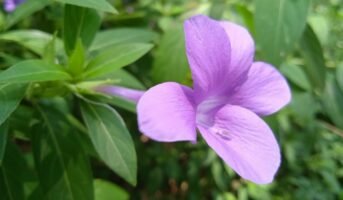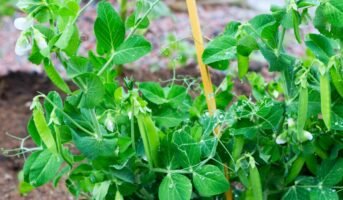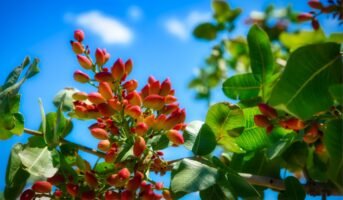Today’s world is filled with concrete forests, and humans are moving far from nature. Therefore, we should develop practices like gardening and planting trees to save our environment. We can do it by building a green space in our house by planting trees. A green space is a garden or terrace filled with plants and trees. Such green corners in our house refresh and calm our mind. It also helps us overcome the stress and tiredness of our entire day. You can also enjoy the mesmerizing beauty and the sweet fragrance of fruits and flowers within your house. Isn’t that amazing?
Now, the confusion that may come up in your mind is which trees to plant. To resolve your dilemma, we have a suggestion for you – Polyscias Scutellaria. It is an ornamental plant often used to decorate rooms and offices. The Polyscias Scutellaria plant is relatively easy to grow but grows at a moderate pace. It originated in the islands of the Pacific Ocean, especially New Guinea and other surrounding islands. These days it is found in India, Central America, and many parts of Africa.
What is Polyscias Scutellaria?
Polyscias Scutellaria is an herbaceous shrub that grows in tropical regions. It is also known as Balfour Aralia, Dinner Plate Aralia, Fabian Aralia, Shield Aralia, Plum Aralia, etc. It belongs to the Araliaceae family. It can be grown from seeds or vegetatively propagated from stem cuttings.
Polyscias plant consists of beautiful white flowers that treat the eyes. The Polyscias Scutellaria plant is used for its aesthetic pleasure, medicinal importance, and commercial viability. It is comparatively easy to grow and requires a moderate amount of maintenance. It will not consume too much of your time and effort to remain beautiful and blooming. However, you must follow some points to get a beautiful Polyscias plant that can be used to decorate your room. First, you must be aware of various facts about the Polyscias plant. Come, let’s have a look at some of those facts and figures.
Basic facts about Polyscias scutellaria
| Name of the Species | Polyscias scutellaria |
| Taxonomic tree | Domain: Eukaryota
Phylum: Angiospermae Family: Araliaceae Subfamily: Araliaceae Genus: Polyscias Species: scutellaria |
| Plant type | It is a shrub
Vegetatively propagated It is an evergreen plant Perennial plant |
| Distribution | Polyscias scutellaria is native to the islands of the Pacific Ocean, especially New Guinea and other surrounding islands. These days it is found in India, Central America, and many parts of Africa. |
| Other names | It is also known as Balfour Aralia, Dinner Plate Aralia, Fabian Aralia, Shield Aralia, Plum Aralia, etc. |
| Cultural/amenity | Impact- Positive |
| Human health | Impact- Positive |
| Uses | It is used for enhancing décor, medicinal research, and other commercial purposes. |
| Maximum Height | 3 – 4 m (120 to 160 inches) High at maturity. Some varieties may reach up to 6 meters. |
| Temperature range | It grows well in warmer areas and is intolerant to chilly winters. |
| Maintenance | Low maintenance required |
How to grow Polyscias Scutellaria?
The Polyscias Scutellaria plant is comparatively easier to grow than other ornamental plants. But, you need a beautiful and blooming plant to place as a piece of décor in your room. And to make this happen, you need to follow some guidelines to help you grow and take good care of the Polyscias plant. Besides, you need to be aware of a few characteristics and requirements that need to be fulfilled for the proper growth of the plant. So, let’s look at those specific wants of the Polyscias Scutellaria plant.
-
Soil
The Polyscias Scutellaria plant is best to be grown in loamy soil containing a small amount of sandy soil. The plant requires alkaline soil to grow well. Must maintain the pH of the soil within a range of 8 – 8.5. Acidic soil can hamper the plant’s growth and eventually decrease its yield.
The plant possesses a thick and robust stem that needs to be supported by an extensive root system. The soil needs to be added with some perlite to increase its rigidity. It will increase the root strength, as well as the aeration in the soil.
-
Water
Polyscias plant doesn’t require water now and then. You must water it only when the soil is half dry or else, after every 2 – 3 days. The plant has a shallow root system. Its roots may get rotten if kept in standing water. Water this beautiful plant to a point where the soil is moderately moist, and remember that during winters, the water requirement decreases gradually.
-
Sunlight
The Polyscias Scutellaria is a summer-loving plant. Therefore, it requires a spot with direct sunlight throughout the year. The plant can adapt to a wide range of the sun, but foggy days are not suitable for it.
-
Temperature & humidity
The Polyscias Scutellaria plant thrives in a temperature ranging between 18 – 29 C (70 – 80 F). A colder environment is fatal for the Polyscias plant, and it cannot thrive at temperatures below 15 C. The required temperature range is easily achievable in the tropics. But if you live in a hilly or colder place, special care needs to be taken of this plant.
Polyscias plants love to be in a humid environment. It requires high humidity around it to bloom gracefully. The humidity of around 75 % is best for the plant. Humidity levels below 30% are harmful to the growth of the plant.
-
Fertiliser
The Polyscias plant requires well-fertilized soil. Therefore, you need to fertilize it every alternate month. Slow-release fertilizers are best for this plant. You must dilute the fertilizer before applying it. Else, it can burn the roots of the plant. Proper soil testing is recommended before planting the Polyscias plant. It will help you to determine the essential nutrients missing from the soil.
Tips for maintaining Polyscias Scutellaria
The Polyscias Scutellaria plant doesn’t require much maintenance. However, a few factors are neglected, which can hamper the growth and beauty of your favorite Polyscias plant. Here are some of them.
-
Repotting
You must transfer the Polyscias plant to a larger pot every 3 – 4 years. The new pot must be at least 2 – 3 inches deeper and 2 – 4 inches wider than the previous one. If you notice root outgrowths at the soil‘s surface, report your plant immediately. Try to repot your plant during the spring season, as the faster growth rate of the plant will help it adapt to the new environment quickly.
-
Pruning
Polyscias plant needs to be pruned after a regular interval. Pruning improves the growth of the plant. It also enhances branching and leaf growth. Pruning is necessary for almost all plants. However, it doesn’t hamper your plant’s growth in any way. All you need to do is take a pair of sharp scissors and cut the topmost main branch of the plant.
-
Weeding practices
Weeds utilize the nutrient available in the soil and deprive the Polyscias plant of its essential nutrients, which eventually leads to the weakening and death of the plant. You can remove these weeds by applying weedicides, such as Herbicides, 2-3 times every year at regular intervals. Please don’t pull the weeds with your hand, as it can damage the roots developing inside the soil.
-
Pests & diseases
Pests often attack the Polyscias plant. They severely hamper the plant’s growth and may be fatal in the long run. Some common problems of the Polyscias plant are Red Spider mites, Scale insects, Aphids, small green or black flies, etc. You need to take special care of the plant to prevent it from such deadly pests.
Root rot and fungal rust are significant diseases that may attack the Polyscias plant. Therefore, it must be provided with all essential nutrients and cared for prevention from these pathogens.
Benefits of Polyscias scutellaria
The Polyscias Scutellaria plant is endowed with numerous benefits. It is used for its aesthetic pleasure, medicinal importance, and commercial viability. But, first, let’s look at some of the practical uses of this plant.
- The leaves and roots of the Polyscias plant possess antimicrobial properties. Therefore, they are used as an ingredient to manufacture antiseptics and deodorants.
- The native Indonesians used the Polyscias plant as a substitute for a bowl to serve food due to its tear-resistant properties.
- Nowadays, Indonesians use the Polyscias plant leaves for fancy packaging and gift wrapping.
- Polyscias plant leaves contain aromatic properties. Therefore, they can mix them with meat or fish to conceal the odor.
- Polyscias leaf extract is used as a reducing agent and stabilizer in the green synthesis of gold nanoparticles.
There are many more benefits of the Polyscias Scutellaria plant. Several kinds of research and debates are going on to prove this plant’s various medicinal and commercial uses.
To sum up, the Polyscias Scutellaria plant is one of the best plants in your room as a piece of décor. It will enhance your room’s beauty and provide a sense of calmness. It will give you the energy to rush all around the day. Its beautiful white flowers are a treat to the eyes. Moreover, the Polyscias plant is easy to grow and maintain.
Additionally, the Polyscias plant provides several other medicinal and commercial benefits. You can grow this beautiful plant from seeds or by propagating it vegetatively from stem cuttings. You can get them from any nearby nursery or order them from an online shopping store.
FAQs
Is Polyscias Scutellaria an indoor plant?
Yes, Polyscias Scutellaria is an indoor plant. It is a unique and lesser-known plant that is ideal for decorating your room. There is something very relaxing and soothing in the vibe of this plant. The plant helps to lighten the mood of a person sitting in its close vicinity.
How long does Polyscias Scutellaria take to grow?
It takes around 2 -3 years for a Polyscias plant to grow and reach its maximum height. You need to stay patient and take good care of the plant. Only then can you watch it bloom gracefully after maturity.
Is Polyscias Scutellaria poisonous?
Yes, Polyscias Scutellaria is a poisonous plant. It contains a few chemicals, like oxalates, glycosides, etc., that may harm children and pets. These chemicals can cause swelling in the lips, mouth, and throat. It can also lead to breathing problems. Therefore, it is best to keep toddlers away from this plant.
How do you propagate the Polyscias Scutellaria plant?
Polyscias Scutellaria plant can be grown by two methods. One is obviously by planting seeds, but the second is via vegetative propagation. You can vegetatively propagate Polyscias plants from stem cuttings. For example, you can plant a stem of the Polyscias plant in the soil and grow the entire plant from it.
How long does Polyscias Scutellaria grow?
The Polyscias Scutellaria plant may grow as high as 3 – 4 meters (120 – 160 inches) at maturity. The wild varieties may grow even higher, up to 5 – 6 meters.
When to sow Polyscias Scutellaria seeds?
Polyscias plant delivers the best growth in the spring season. Therefore, planting the Polyscias Scutellaria seeds during the spring is recommended. However, it would help if you remembered that Polyscias seeds would not germinate appropriately during the winter, as it enters a dormancy phase during that part of the year.
Housing News Desk is the news desk of leading online real estate portal, Housing.com. Housing News Desk focuses on a variety of topics such as real estate laws, taxes, current news, property trends, home loans, rentals, décor, green homes, home improvement, etc. The main objective of the news desk, is to cover the real estate sector from the perspective of providing information that is useful to the end-user.
Facebook: https://www.facebook.com/housing.com/
Twitter: https://twitter.com/Housing
Email: [email protected]











